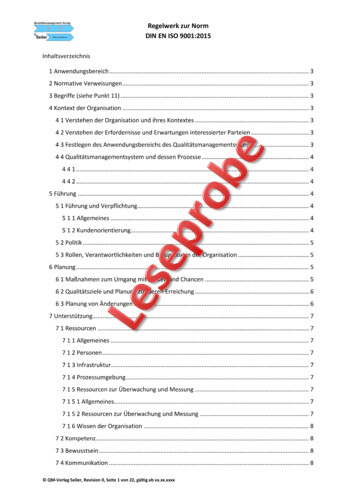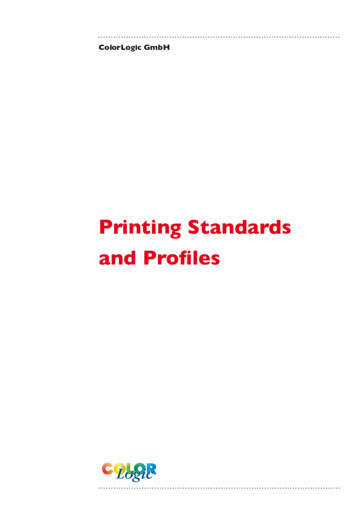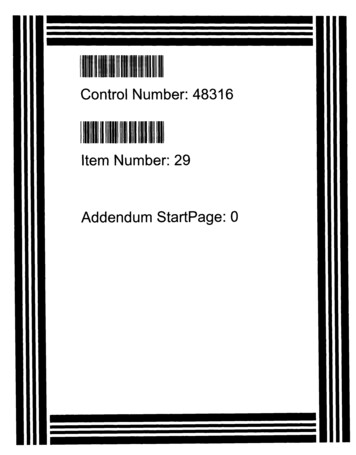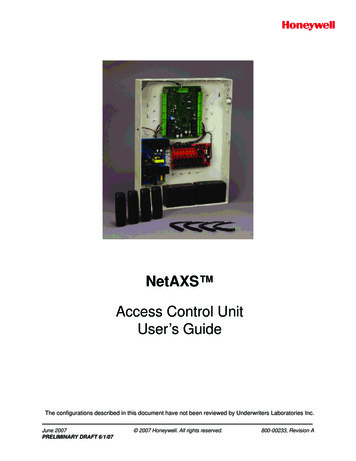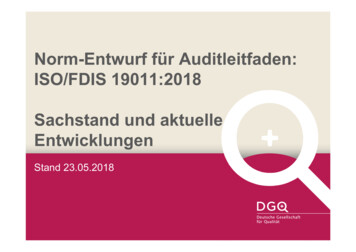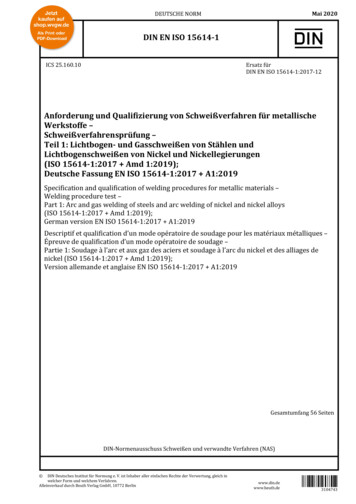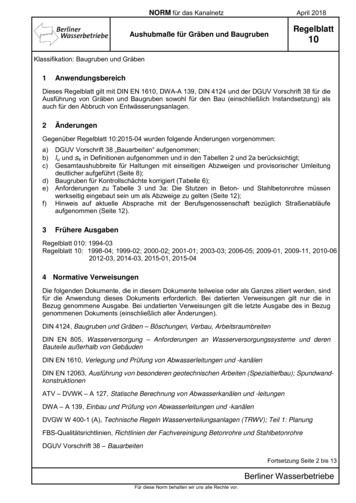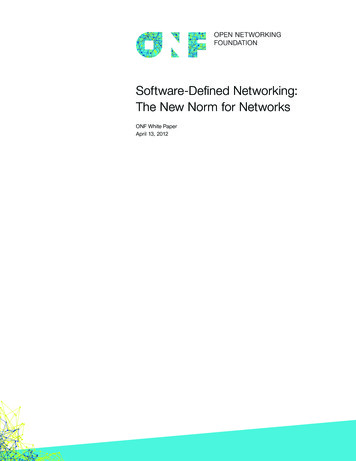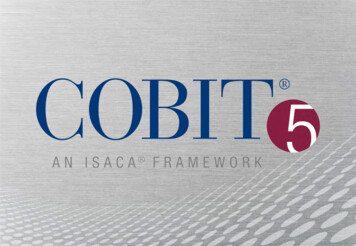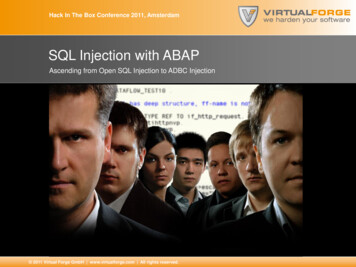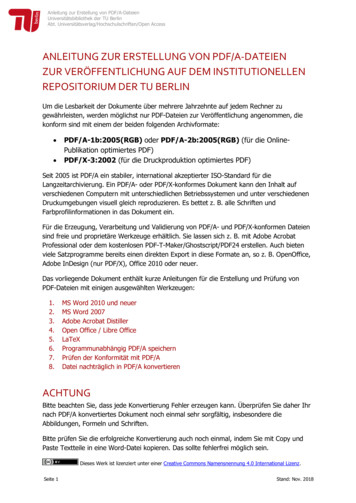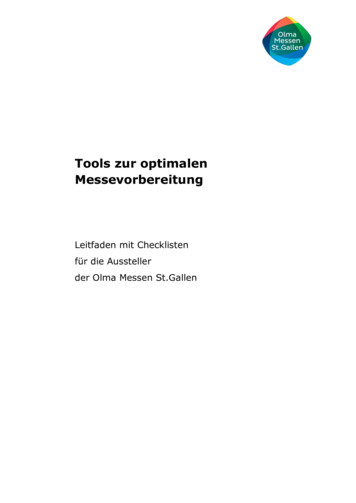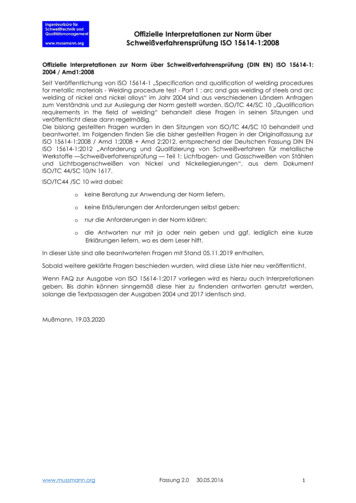
Transcription
Offizielle Interpretationen zur Norm überSchweißverfahrensprüfung ISO 15614-1:2008Offizielle Interpretationen zur Norm über Schweißverfahrensprüfung (DIN EN) ISO 15614-1:2004 / Amd1:2008Seit Veröffentlichung von ISO 15614-1 „Specification and qualification of welding proceduresfor metallic materials - Welding procedure test - Part 1 : arc and gas welding of steels and arcwelding of nickel and nickel alloys“ im Jahr 2004 sind aus verschiedenen Ländern Anfragenzum Verständnis und zur Auslegung der Norm gestellt worden. ISO/TC 44/SC 10 „Qualificationrequirements in the field of welding“ behandelt diese Fragen in seinen Sitzungen undveröffentlicht diese dann regelmäßig.Die bislang gestellten Fragen wurden in den Sitzungen von ISO/TC 44/SC 10 behandelt undbeantwortet. Im Folgenden finden Sie die bisher gestellten Fragen in der Originalfassung zurISO 15614-1:2008 / Amd 1:2008 Amd 2:2012, entsprechend der Deutschen Fassung DIN ENISO 15614-1:2012 „Anforderung und Qualifizierung von Schweißverfahren für metallischeWerkstoffe —Schweißverfahrensprüfung — Teil 1: Lichtbogen und Gasschweißen von Stählenund Lichtbogenschweißen von Nickel und Nickellegierungen“, aus dem DokumentISO/TC 44/SC 10/N 1617.ISO/TC44 /SC 10 wird dabei:okeine Beratung zur Anwendung der Norm liefern,okeine Erläuterungen der Anforderungen selbst geben;onur die Anforderungen in der Norm klären;odie Antworten nur mit ja oder nein geben und ggf. lediglich eine kurzeErklärungen liefern, wo es dem Leser hilft.In dieser Liste sind alle beantworteten Fragen mit Stand 05.11.2019 enthalten.Sobald weitere geklärte Fragen beschieden wurden, wird diese Liste hier neu veröffentlicht.Wenn FAQ zur Ausgabe von ISO 15614-1:2017 vorliegen wird es hierzu auch Interpretationengeben. Bis dahin können sinngemäß diese hier zu findenden antworten genutzt werden,solange die Textpassagen der Ausgaben 2004 und 2017 identisch sind.Mußmann, 19.03.2020www.mussmann.orgFassung 2.030.05.20161
ISO/TC 44/SC 10 N 1617Type of question: InterpretationISO/TC 44NumberISO 15614-1 :2004/Amd 1 :2008Subclause numberSC in chargeFig. 510Specification and qualification of welding procedures for metallic materials - Welding procedure test - Part 1 : arcand gas welding of steels and arc welding of nickel and nickel alloysQuestionHardness measurements should be performed in the coldest area (should be near the start)On a butt weld, the location of the hardness measurements is on location 6 (near end).Shouldn’t this be changed?Answer proposed by the author of the questionHolger Zernitz (Secretary of ISO/TC 44/SC 10):I agree with you, it makes no sense to have different locations for the hardness test specimen in a BWand in a T-joint. But although it is only a problem for welding without preheating. But also in this casethe location of the hardness test specimen is not very important, because after 30 mm length of theweld the heat input should be high enough not to affect the results of the hardness test. Nevertheless,I agree that in the BW and a T-joint the location of the hardness test specimen should be similar!Therefore, we will modify figure 5 regarding the probe for hardness testing to the opposite position.Answer of the responsible ISO/TC 44/SCsAccepted by ISO/TC 44/SC 101
Type of question: InterpretationISO/TC 44NumberISO 15614-1 :2004/Amd 1 :2008Subclause numberSC in charge7.4.1 and 7.4.210Specification and qualification of welding procedures for metallic materials - Welding procedure test - Part 1 : arcand gas welding of steels and arc welding of nickel and nickel alloysQuestionI have a question regarding with extend of Tensile Testing described in Standard EN 15614-1 at item 7.4.1 and7.4.2.As per Table 1 referred by item 7.4.1 Tensile Test pieces to be extracted (from any size of plate) is defined astwo. (Pls. see attached file)Whereas, EN 895 recently replaced by DIN EN ISO 4136 states at item “5.5.2 Location - When a relevantapplication standard requires testing of the full thickness 30mm several test specimens may be taken to coverthe full thickness of the joint.” (Pls. see attached file)My question: What shall be the number of tensile test specimens for a butt welded test coupon with thickness200mm? Two or more specimens to be extracted to represent full thickness (See attached example) depending onthe capacity of the tensile testing machine?2
Type of question: InterpretationISO/TC 44Tolga KantaroğluAnswer proposed by the author of the question-Answer of the responsible ISO/TC 44/SC sISO/TC44/SC 10 meeting on 2015-07-07 in Helsinki, Finland:.According to clause 7.4.2, tensile testing shall fulfill EN 895 (new ISO 4136). In clause 5.5.2 inISO 4136, a relevant application standard may require more than one specimen to cover thewhole thickness. This additional requirement isn't required in ISO 15614-1, clause 7.4.2. Note:An additional requirement to cover the whole thickness with more than one specimen will beconsidered for the next issue of ISO 15614-1.NumberSubclause number3SC in charge
Type of question: InterpretationISO/TC 44NumberISO 15614-1 :2004Subclause numberSC in charge7.4.510Specification and qualification of welding procedures for metallic materials - Welding procedure test - Part 1 : arcand gas welding of steels and arc welding of nickel and nickel alloysQuestion- Is our understanding correct, that the last sentence in para 7.4.5 quote “Where multiple welding processes arequalified in a single test piece, impact test specimens shall be taken from the weld metal and HAZ that include eachprocess.” Unquote is applicable for two or more (multiple) processes only, which shall be qualified separately inone test piece for use in single-process WPS?- Does it mean that the quoted requirement is not applicable for multi-process procedures, for which the combinationand sequence of weld-processes is equal in the corresponding WPS?- Does it also mean that a single testing of the overall weldmetal (e.g. by one set of notch impact specimen forweldmetal and one for HAZ as defined by standard), without differentiating between the different weld process andweld metals, which have been applied, qualify all processes and weld metal of the whole multi-process joint?A difference between the single use of each process (“multiple welding processes” acc. to para 7.4.5) and a “multiprocess” use is made. Also the “NOTE” in para 8.4.1 is emphasizing this understanding.Bilfinger Piping owns several welding procedure qualifications on pipes above wall thickness 30 mm, in which the rootis welded with process 141 (TIG) and filling is done with other processes, as 111 or 121 (SMAW or SAW). Thecorresponding WPS specifies the same multiprocess sequence. Impact testing on weld metal and heat affected zone,had been performed 2 mm below outside surface, as required by EN ISO 15614-1. A client believes that additionalImpact Testing (WM and HAZ) on the TIG-root for all multiprocess welding procedures is mandatory and now likely toquestion our qualified WPQRs. This does not fit to our understanding of the standard and the different wording used init.Answer proposed by the author of the questionIt is allowed, to use multi-process procedures with two sets of impact specimen (WM and HAZ) only.Additional impact testing on each process (e.g. TIG-root) is not required, if the corresponding WPSspecifies the same combination and sequence of weld-processes.Answer of the responsible ISO/TC 44/SCsAnswer from ISO/TC 44/SC 10 on 2013-10-15 in ParisThe answer is NO, unless the weld covers only two processes and the specimens are taken from theweld metal and HAZ that include both processes.4
Type of question: InterpretationISO/TC 44NumberISO 15614-1 :2004/Amd 1 :2008Subclause numberSC in charge7.4.610Specification and qualification of welding procedures for metallic materials - Welding procedure test - Part 1 : arcand gas welding of steels and arc welding of nickel and nickel alloysQuestionNew steels with min ReH 960 to 1100 MPa that are thermomechanically treated, so called directquenched, fine-grain steels are according to ISO/TR 15608 grouped as 2.2, since they are nottempered. However, they typically get 400 HV in HAZ which is fine since the low carbon contentpresent a relative ductile hardened structure. The situation is therefore similar as for the materials ingroup 3.In ISO 15614-1 table 2 the materials in group 3 has a footnote b saying “For steels with min ReH 890MPa special values shall be specified”. This means that the specified/permitted maximum hardnessvalues come from the steel manufacturer.Question:For procedures qualified according to ISO 15614- 1:2004, what is the permitted maximum hardnessvalue (HV 10) for steels in material group 2 according to ISO/TR 15608:2005 with min ReH 890 MPa?Answer proposed by the author of the questionAnswer of the responsible ISO/TC 44/SCsmeeting on 2010-10-23 in Hannover:ISO 15614-1:2004 table 2 footnote b saying “For steels with min ReH 890 MPa special values shallbe specified” also covers materials in group 2 according to ISO/TR 15608:2005.5
Type of question: InterpretationISO/TC 44NumberISO 15614-1 :2004/Amd 1 :2008Subclause numberSC in charge8.210Specification and qualification of welding procedures for metallic materials - Welding procedure test - Part 1 : arcand gas welding of steels and arc welding of nickel and nickel alloysQuestionCan a manufacturer simply give his qualified WPS to a subcontractor to perform the welding?Is that WPS valid in this case?Answer proposed by the author of the questionThe standard says that it can be done in this way as long as the manufacturer retains the completeresponsibility for all welding. The welding coordinator will have to supervise the welding so that he issure the WPS is used in a good way.Answer of the responsible ISO/TC 44/SCsDeclined by ISO/TC 44/SC 106
Type of question: InterpretationISO/TC 44NumberISO 15614-1 :2004/Amd 1 :2008Subclause numberSC in chargeRange of qualification of a fullpenetration T-joint10Specification and qualification of welding procedures for metallic materials - Welding procedure test - Part 1 : arcand gas welding of steels and arc welding of nickel and nickel alloysQuestiona) Range of qualification of a full penetration T-joint: bottom plate is 30mm, plate on top is 10 mmthickb) According table 1 remark “f”:Which thickness needs to be taken for the butt weld qualification? 10 mm or 30 mm?Answer proposed by the author of the questiona) A T-joint full penetration is considered as a butt weld, so the range of qualification for a butt has to beapplied. Since the plates for butt weld should have the same thickness, it is not specified in the standard.Par 8.3.2.1 specifies which thickness you should take into account for a T-joint full penetration:and not “thicknessesIn this case which thickness has to be taken into account?1)The plate thickness that is foreseen with the weld preparation or2) should the range of qualification on both plates independent to be taken into account because it ismentioned in EN ISO 15613 and this piece is no standard test piece:In case 1: the range is from 3 mm to 20 mm (consequence is that the thickness of the bottom plate doesn’tmatter while a thicker plate will cause rapid cooling higher hardness)In case 2: the range is from 15 mm to 60 mm on 3 mm to 20 mmb) One needs to use the plate thickness that is foreseen with the weld preparation.If in this case the 10 mm plate is foreseen with a bevel, one should do a butt weld qualification with 2plates of 10 mm.Answer of the responsible ISO/TC 44/SCsISO/TC 44/SC 10 meeting on 2015-07-07 in Helsinki, Finland:a) The plate thickness that is foreseen with the weld preparation.b) 10 mm is qualified.7
Type of question: InterpretationISO/TC 44NumberISO 15614-1 :2004/Amd 1 :2008Subclause numberSC in chargeRange of qualification of apartial penetration T-joint10Specification and qualification of welding procedures for metallic materials - Welding procedure test - Part 1 : arcand gas welding of steels and arc welding of nickel and nickel alloysQuestiona) Range of qualification of a partial penetration: T-joint: bottom plate is 40mm, plate on top is 20 mmthick deposited weld thickness is 12 mm.b) According table 1 remark “f”:Which thickness needs to be taken for the butt weld qualification? 20 mm, 40 mm, 12 mm?Answer proposed by the author of the questiona) Since this is no standard test piece, EN ISO 15614-1 does not apply. In this case, it is EN ISO 15613 thathas to be used.One plate has a weld preparation, so the table for butt weld is applicable.Possible interpretations:1) Apply the range for each of the plate thicknesses separate. So the range is from 10 mm to 40 mm on 20mm to 80 mm. Regarding the deposited weld thickness? (the deposited weld thickness is the maxthickness?)2) Apply the range only on the deposited weld thickness. So the range is from 3 mm to 24 mm.is thatthe thicknessAnswer(consequenceof the responsibleISO/TC44/SCs of the bottom plate doesn’t matter while a thicker plate will cause rapidcooling higher hardness)3) Apply the range on the bottom plate and on the deposited weld thickness. So the range is from 3 mm to824 mm on 20 mm to 80 mm.
Type of question: InterpretationISO/TC 44ISO/TC 44/SC 10 meeting on 2015-07-07 in Helsinki, Finland:Since this is no standard test piece, ISO 15614-1 does not apply. In this case, it isISO 15613 that has to be used.9
Type of question: InterpretationISO/TC 44NumberISO 15614-1 :2004Subclause numberSC in charge8.3.110Specification and qualification of welding procedures for metallic materials - Welding procedure test - Part 1 : arcand gas welding of steels and arc welding of nickel and nickel alloysQuestionMaterial grouping of 16Mo3 steel16Mo3 - seamless tube for pressure purposes with Remin 280 N/mm2, acc. to EN 10028-2belongs to sub-group 1.2. (acc. chemical composition and mechanical properties).The other similar 16Mo3 products (tubes with thk. 16 mm, p
In ISO 15614-1 table 2 the materials in group 3has a footnote b saying “For steels with min R. eH 890 MPa special values shall be specified”. Thismeans that the specified/permitted maximumhardness values come from the steel manufacturer. Question: For procedures qualified according to ISO 15614-1:2004, what is the permitted maximum hardness
